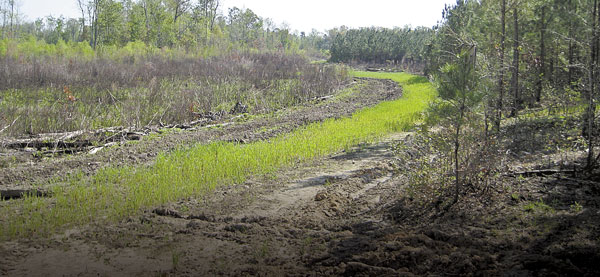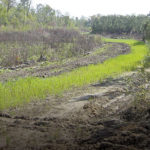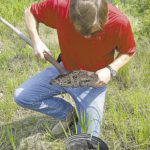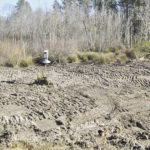
Our cool-season food plots often make or break us in the fall. Nothing excites a hunter more than a trophy buck prancing across one of our food plots, knee deep in a lush field of greens. Rich and hearty food plots quickly pay us back after we have logged countless hours in the fields to make them what they eventually become. If a nice deer shows up to enjoy the plot, it’s just a bonus with bragging rights to spread around the hunting cabin. With just a few months until the planting season begins, wildlife managers need to develop a planting plan for each cool-season food plot on the horizon.
A successful food plot is something to be proud of under any condition. But these plots do not grow themselves — or do they? With proper preparation, attention and a decent site to work with, anybody can successfully allow a bag of seed to grow to maturation in the Carolinas. But food-plot cultivation can be a substantial project, with many days spent in the field. Site and seed choice are critical and should be chosen wisely, paying close attention to preferred chemical and physical requirements of the seed. All commercial seed-package labels offer optimal conditions required for each seed variety.
Most fall plantings generally will have components of perennial or annual clover, brassicas, or small grain-type planting varieties. With the many planting mixes and seed varieties available, wildlife managers can customize their plantings around the physical and chemical characteristics of each prospective plot site located throughout a piece of land. Sites will vary tremendously in drainage class, soil texture, acidity, and shade/sun abundance. Match plot varieties to their preferred conditions before sowing the first seed.
None of the favored plant species will grow under extremely dry or frequently-flooded conditions with any significance or at all. Overall, all prospective food-plot sites should be chosen with the ability to retain moisture within the soil for a long duration without being saturated or inundated. However, many seed varieties differ tremendously from preferred soil-moisture availability. Choose well-drained sites for the more drought-tolerant species and wetter sites for varieties requiring wetter conditions.
Essentially, the dirt is where the nutrients and minerals hang out. Soils are made up of a combination of particle sizes and shapes, including silt, sand and clay. The surfaces of most soils will also contain a level of organics or a layer of partially-decomposed plant material. While most silt and clays are roughly the same size, their shapes are different. Sands come in different sizes, but are practically the same shape and are the largest of the soil particles. The higher the sand component within a soil, generally, the faster water molecules can travel. But most soils are loams or have a combination of silt, clay and sands. Soils vary from site to site even on small properties. Many food-plot seeds prefer loamy soils, while others prefer a more sandy texture. Check out the soil texture of each food-plot site and determine its texture before assigning a seed for an area. The U.S. Natural Resources Conservation Service county soil survey can be a good resource. The soil-survey data has maps and soils descriptions that can provide a guide to the expected soils and locations of expected soils on a parcel of land.
Having the proper pH is an absolute must and is the most important factor in establishing a food plot. Without the preferred pH environment, the seeds will never get a chance to grow properly and the resulting yield will be spent money and time wasted. The proper pH allows the plants to utilize the fertilizer and knowing what fertilizer composition is needed to meet the needs of the crop. Soil pH will only vary throughout the site to a small degree. Most sites in the South have naturally-low pH levels, and liming often plays into the picture. But some food-plot seeds are more acid-tolerant than others that require a more balanced pH. If liming is not a part of the soil-preparation plan, choose acid-tolerant seed mixes within low pH sites.
Lastly, plants need sunlight to photosynthesize, and very few plants can make it without full sun for at least a few hours of the day. As a general rule, choose food-plot sites with adequate sunlight penetration. The majority of food-plot seeds require five to six hours of full sunlight to reach full potential. But there again, some plants are more shade-tolerant than others with the ability to establish well on sites littered with substantial tree canopy. Prescribe shade-tolerant food-plot mixes within wooded sites with limited, prolonged sunlight exposure.
Warm-season plantings back in March through June of soybeans, peanuts and corn may also be a part of the fall-season food budget and should be considered as part of the overall plot management goal.
The middle of the summer brings scorching-hot weather, and deer hunters rarely consider planting food plots or preparing the soil for the upcoming planting season. Well, after all, it is the peak of summer. But, planting season is just three to four mouths out, and planning and some much needed preparation should be underway this month.
Condition soil in waterfowl impoundments
By July, many waterfowl impoundments are covered in young corn plants to allow for adequate maturation. Corn makes its way into many waterfowl impoundments throughout the nation, and probably for good reason; ducks just love that sweet golden kernel.
But early August plantings of Japanese millet, sorghum, and buckwheat are also excellent options to provide migrating ducks with a tasty food source, and they have a short maturation window. Just as with any other food plot, the soil must be prepared to grow the seeds effectively. Soil pH must be corrected first in order for the food plot seeds to process the fertilization measures later.
Most impoundment sites are lower in elevation within organic soils. They have a tendency to have naturally-acidic soils and receive acidic waters during typical impoundment flooding. Limestone application should always be a first action before planting waterfowl impoundments in
summer.
In preparation for an early August planting, impoundments should be plowed or disced to expose soil in preparation for a limestone application. Limestone conditioning should be a first action at least one month prior to planting. The rate of limestone application per acre should be determined by a portable pH soil meter or from a soil analysis conducted by the county extension service. However, one ton of limestone per acre is a good general application rate to raise pH to acceptable levels for planting these species.
Put your dirt to the test!
Having the proper pH and chemical composition is an absolute must and is the most important factor in establishing a food plot. Without the right nutrients and a pH balanced environment, seeds will never get a chance to grow properly, and the resulting yield will be spent money and time wasted. The proper pH allows plants to utilize the fertilizer and knowing what fertilizer composition is needed to meet the needs of the crop.
As most soil types for an area can be identified on a county soil survey, the actual site may contain concentrations and/or deficiencies of certain nutrients and may have a differing level of acidity. Before any fertilizer or other soil conditioners are added to the soil, a standard soil analysis must be conducted to determine the soil’s actual chemical composition. Soil samples should be collected from six to eight inches deep. Each food plot should have its own soil test, but soil should be taken from five to six different locations around each plot to get a good representative sample of soils occurring for the analysis. Clemson Extension Services in South Carolina will run the analysis for $6. The N. C. Department of Agriculture does not charge for a standard soils analysis.
Acidic soils are treated with supplements of limestone as a soil conditioner. Limestone application should be done one to two months prior to planting to allow penetration and chemical activation within the soil. Most cool-season food plots are planted between Sept. 1 and Oct. 31. Therefore, soils should be gathered and tested during the first couple of weeks of July to allow for additional time at the processing facilities.







Be the first to comment